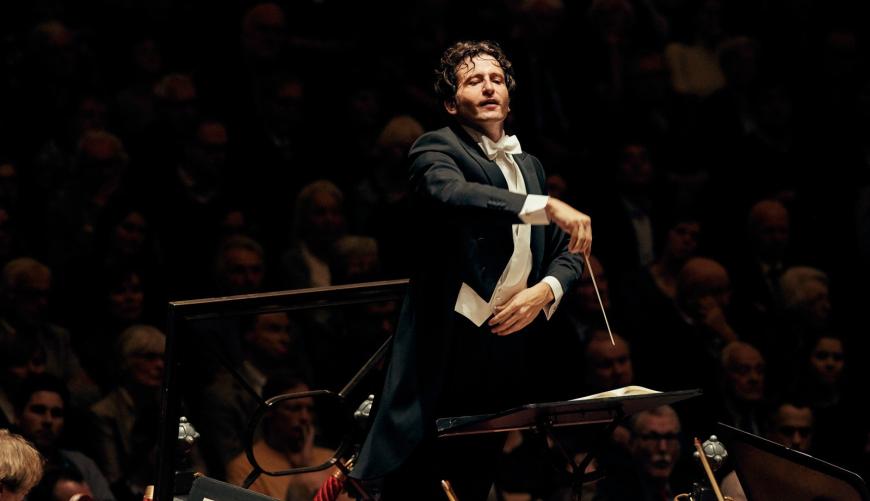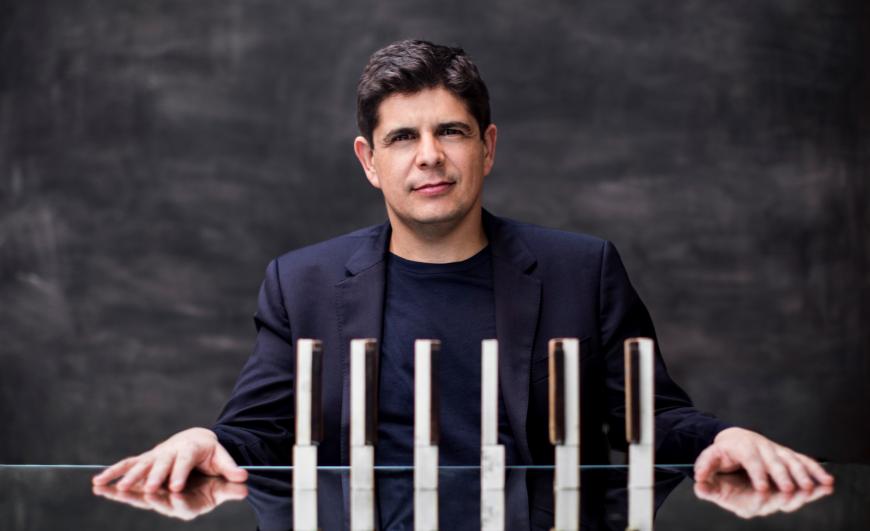
A couple of Spaniards took over Walt Disney Concert Hall Sunday afternoon (Nov. 27), and everything went right. Everything. The Los Angeles Philharmonic was on its toes, the program was interesting within the context of the usual overture-concerto-symphony drill, and the performances had the extra zip of heightened involvement with the material. When the boss, Gustavo Dudamel (now a Spanish citizen himself), comes back into town for December’s concerts, he’ll find a well-tuned vehicle ready to drive.
The conductor who was doing the tuning over Thanksgiving weekend was Gustavo Gimeno, 46, now the music director of the Orchestre Philharmonique du Luxembourg — with which he has made some fine recordings, such as a Stravinsky mini-box spanning 50 years of the composer’s output — and as of 2020 the Toronto Symphony, which just renewed his contract through 2030. His Spanish cohort at the piano was Javier Perianes, 44, who despite having worked with several of the big names in the classical world is still not as well known here as he should be, judging by his splendid performance Sunday.

First up was the U.S. premiere of Aqua Cinerea, a 10-minute tone poem by another Spaniard, Francisco Coll, who composed it when he was all of 19. Now 37, Coll trimmed the “transitional material” out of the score three years ago in the interest of tightening up the piece. What’s left is a vaguely expressionistic, slow-paced, yet succinct work that explodes with color in spots and relaxes with faint touches of Tristan und Isolde and perhaps Wozzeck before it goes crazy again just before the quiet ending. Among other effects from the huge assembly of percussion instruments and found objects is the sound of a player punching a plastic bag filled with scrap paper.
Camille Saint-Saëns wrote five piano concertos — the same number as Beethoven and Prokofiev — but we seldom hear them in concert even though all of them are worthy, audience-friendly vehicles that contain passages of first-rate material, as well as room for the soloist to show off some firepower. Perianes went for the Concerto No. 5, which adds the extra attraction of unpredictability that might be inferred from the concerto’s subtitle, “The Egyptian.” All things “Egyptian,” though, are confined to the slow movement, where the orchestra leaps into North Africa at the outset and the soloist takes a startling detour into a Nubian tune and modal rhetoric in mid-movement — and suddenly we listeners are lost in the desert, at least until the finale begins.
In Perianes’s hands, the treble notes sparkled with a flexible, sometimes lighter-than-air touch and not too much pedal — and he knew how to mold phrases to logical conclusions. The coda was rattled off at a blazing speed, with Gimeno and the LA Phil unified behind the pianist at all times. There were more fireworks to come as Perianes dashed through Manuel de Falla’s “Ritual Fire Dance” (yet another Spaniard) with plenty of motor drive and ripped glissandos.

Dmitri Shostakovich’s Symphony No. 5 is his best-known symphonic work and also paradoxically one of his most enigmatic. The root of the enigma comes from the coda of the finale. After all of the anger, suffering, sarcastic humor, and moments of dark repose that come before, is this ending the triumphant statement of a Soviet artist who overcame extreme adversity? Or is it, as Shostakovich’s friend Mstislav Rostropovich described it, like being tortured on the rack, each blaring chord stretching the rack further? Gimeno seems to favor the rack metaphor, for he slowed the tempo down for the crucial coda, with the nagging strings and winds and the nerve-prodding brasses and drums giving the impression of a forced confession.
On the way to that conclusion, Gimeno had an electrifying grip on the symphony. The emphatic opening intervals foretold a first movement of underlying tension beneath deceptively calm, Zen-like surfaces and a militant central march full of terror, the whole structure held tightly together. The bassists and cellists tore into the opening of the scherzo with an intensity beyond anything I’ve heard before in live performances of the Fifth — and the agonized climax of the slow movement and dynamic, quick-paced rumbling of the finale’s opening maintained that intensity.
This was a sensational performance of Shostakovich’s Fifth, one in which Gimeno got the players in the Phil to dig down deeply, to listen to each other, and to explore the depths of a masterwork. The piece has been done often enough that it would have been understandable if they just skated through it on autopilot, as even usually fiery Russian conductors have done. But Gimeno and the Phil wouldn’t settle for routine — even on a long holiday weekend.



